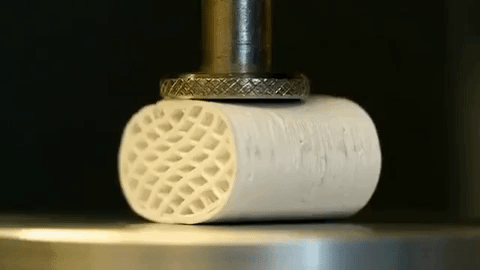
[Image above] Credit: National Science Foundation
It seems like just yesterday we were reporting on 3-D printed ceramic bone implants. Well, actually it was just yesterday.
Today’s video features a 3-D printed flexible ceramic material called Hyperelastic Bone. Created by materials scientist Ramille Shah and materials engineer Adam Jakus, both of Northwestern University, the synthetic bone starts as a liquid ink that is run through a 3-D printer, and formed into various shapes, depending on patient needs. A 2016 paper in Science Translational Medicine describes the composition as “mainly hydroxyapatite and either polycaprolactone or poly(lactic-co-glycolic acid).”
“…3D printing allows us to make patient-specific or patient-matched implants, as well as unique off-the-shelf products that the surgeon can easily manipulate in the operating room,” Shah explains in a National Science Foundation article.
Hyperelastic Bone regenerates bone tissue growth and ultimately becomes the patient’s own bone. “Once implanted inside the body, the Hyperelastic Bone eventually becomes new bone; it becomes part of you,” Jakus explains in the video.
What makes Hyperelastic Bone different from other orthopedic products is that most are very brittle, Shah points out. The researchers created their product from the same material that natural bone is made from, but with elastic properties.
The duo has already established a company, Dimension Inx, to commercialize the technology. “The purpose of Dimension Inx is to make advanced manufacturing, including tissue and regenerative engineering, clinically and economically viable as well as accessible to researchers and industry through the introduction of new advanced materials,” Jakus, who is now chief technology officer of the company, explains in the article. “These materials are not only highly functional, such as Hyperelastic Bone, but are also large-scale-manufacturing and end-user friendly.
“For the past several decades, tissue engineering as a field has been almost entirely relegated to academic laboratories, where great discoveries have been made,” Jakus adds, “but it is now time for innovative technologies and materials to leave the laboratory and make it into the hands of doctors and surgeons where they can be used to help those who need them most, the patients.”
The original paper, published in the Journal of Biomedical Materials Research is “3D printed hyperelastic “bone” scaffolds and regional gene therapy: A novel approach to bone healing” (DOI: 10.1002/jbm.a.36310).
Watch the video below to learn more about Hyperelastic Bone.
Credit: National Science Foundation
Did you find this article interesting? Subscribe to the Ceramic Tech Today newsletter to continue to read more articles about the latest news in the ceramic and glass industry! Visit this link to get started.
